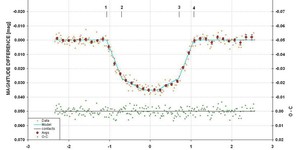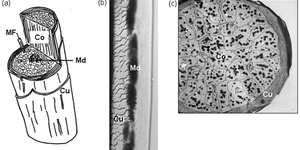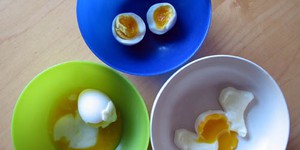High School Science Projects (642 results)
Science Buddies' high school science projects are the perfect way for high school students to have fun exploring science, technology, engineering, and math (STEM). Our high school projects are written and tested by scientists and are specifically created for use by students in the high school grades. Students can choose to follow the science experiment as written or put their own spin on the project.
For a personalized list of science projects, high schoolers can use the Science Buddies Topic Selection Wizard. The wizard asks students to respond to a series of simple statements and then uses their answers to recommend age-appropriate projects that fit their interests.
|
Select a resource
Sort by
|
There is a lot of energy that can be harvested from moving water. Energy can be extracted from water rushing over a waterfall and from the regular patterns of the ocean's tides. The energy that propels waves forward in the oceans can also be extracted and used. But can wave energy power plants be built anywhere there is water? In this energy science fair project, you will use ocean buoy data and mathematics to determine which locations along the coasts of the United States can sustain a wave…
Read more
Featured
Have you heard that garlic powder is supposed to inhibit the growth of bacteria? Which do you think would make a better disinfectant: a solution of garlic powder or a solution of bleach? This project shows you a straightforward way to compare the effectiveness of different disinfectants (or other antimicrobial agents), by measuring zones of inhibition on a culture plate.
Read more
Did you know that a scientific study has shown that chewing Big Red Gum reduces mouth microbes? (ScienceDaily contributors, 2004) The cinnamon oil in the gum is a natural defense against mouth bacteria that cause tooth decay and bad breath. Conduct an experiment to compare products with cinnamon essence in gum, candy, toothpaste, and mouthwash to see if they can decrease mouth germs. Do a before and after swab of the mouth with a Q-tip. Which treatments work the best? Can you find another…
Read more
Caffeine is a type of chemical called a stimulant. When you drink a caffeinated beverage, the caffeine enters into your blood stream dilating the capillaries and causing blood to flow more quickly. This gives your body a feeling of speeding up which can cause the jitters and wakefulness. How does caffeine affect the physiology of other animals? You can use over-the-counter caffeine supplements, like Vivarin, to test the effects of caffeine on animals. Try dissolving the caffeine in…
Read more
You can look up information about local air pollution, such as the Air Quality Index (AQI), online or even get alerts on your phone. But what if you could wear a device that continuously monitors the air quality around you in real time, alerting you to unsafe levels? Such a device could alert a person with asthma when they need to go inside, let you know if smoke from a nearby wildfire is drifting in your direction, or signal when it is time to take a break on a hazy summer day. The Science…
Read more
In astronomy, a transit (or astronomical transit) is a phenomenon when a celestial body passes directly between a larger body and the observer. As viewed from a particular vantage point, the transiting body appears to move across the face of the larger body, covering a small portion of it.
The word "transit" refers to cases where the nearer object appears smaller than the more distant object. Cases where the nearer object appears larger and completely hides the more distant object are known as…
Read more
Many disposable diapers contain a polymer, called sodium acrylate, which is useful for absorbing water. Do background research to learn about sodium acrylate, and how it reacts with water. Make sure that you understand the terms hydrophilic, polarity, hydrogel and hydrogen bonding. Cut out the middle, padded section of a disposable diaper. Cut this into equally-sized square pieces, approximately 10-12 cm on a side. Remove some of the stuffing material so that you can staple the open…
Read more
If you sit under a leafy tree on a sunny day, you may notice spots of sunlight on the ground from light passing through spaces between the leaves. Try putting a piece of cardboard on the ground and examining the spots of light on the cardboard. Even though the spaces through which the light is passing are irregular in shape, the spots on the cardboard are round. What you are seeing, in fact, are projected images of the sun. Light passing through an aperture forms an image. A pinhole camera…
Read more
Does your hair go crazy when the weather turns damp? Did you know that strands of hair can relax and lengthen when the humidity increases and then contract again when the humidity decreases? In fact, hair strands can be used as the basis for a hygrometer, a device which measures the humidity level in the air. Can a human hair hygrometer also detect changes in hair structure caused by chemical lightening? This project shows you how to find out.
Read more
Sometimes on a busy day, it is hard to get things done. The rush to get things done can start first thing in the morning, when you are so busy getting ready and gathering your homework, that you barely have time for breakfast. It takes time to get a nutritious meal ready. But, eggs are a perfect choice for breakfast because they can be cooked quickly and in many different ways. A soft-boiled egg is a choice that many people make. They like the way the thickened, tasty yolk coats their hash…
Read more
Lead is a very hazardous element. Even very small amounts can cause health problems, especially in babies and young children. One way to determine if a household item, such as a toy or a piece of jewelry, contains lead is to soak the item in a solution, and then test the solution for lead that might have leached out of the item. The goal of this chemistry science fair project is to determine how varying the pH of the test solution affects its ability to dissolve lead, which is a critical step…
Read more
|
Explore Our Science Videos
Make a Slushy! Yummy STEM Project
Make a Hygrometer to Measure Humidity – STEM activity
Hydroponics in a 2-Liter Soda Bottle – STEM activity.











